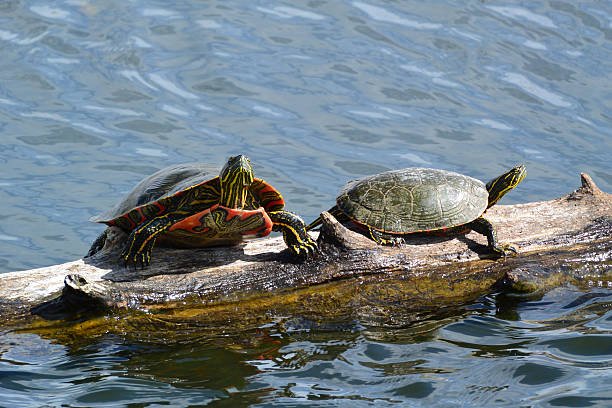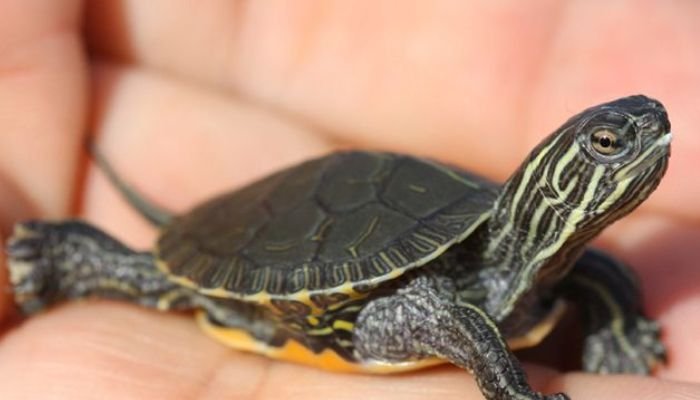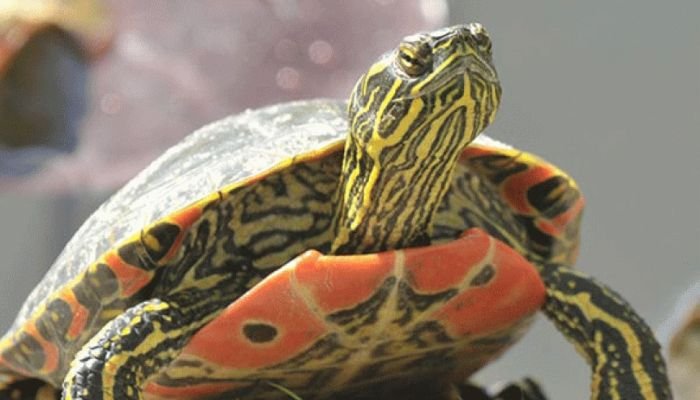
Turtles inhabiting North America include the aquatic and flamboyant Western Painted Turtle. It is a captivating reptile with colorful patterns and a smooth carapace. Western Painted Turtles inhabit ponds, lakes, and still streams, among other watery habitats. They are skilled swimmers and sunbathers who are frequently observed sunning themselves on boulders or logs.. Here are Western painted turtle Guide on Food, Habitat, Size, Lifespan & Predators below-
Western painted turtle Stats in Table format
The stats are given below for Western painted turtle
| Reptiles List | Western painted turtle |
|---|---|
| Family | Emydidae |
| Type | Turtle |
| Size | Small to Medium |
| Length | Western painted turtle: Up to 5-7 inches (13-18 cm) |
| Color | Western painted turtle: The color varies depending on the subspecies, but western painted turtles can have shades of green, brown, or black with red or yellow markings. |
| Weight | Western painted turtle: The weight varies depending on the size and age of the Western painted turtle, but adults can weigh between 1 to 2 pounds.. |
| Lifespan | 20-30 years (or more) |
| Reproduction | Oviparous, lays eggs |
| Gestation Periods | The gestation period for a Western painted turtle is approximately 60 to 80 days. |
| Endangered Status | Least Concern (IUCN Red List) |
| Features | Colorful patterns on the shell, ability to bask |
| Country & Areas | Western painted turtles are found in North America, specifically in the western United States and parts of Canada. |
Western Painted Turtle Natural Habitat and Distribution
In the family Emydidae, the Western Painted Turtle (Chrysemys picta bellii) is found. Typical locations include the Pacific Northwest, California, and western portions of Canada, as one might guess from the name. These turtles thrive in a variety of wet environments, from ponds and lakes to marshes and slow-moving streams with plenty of vegetation. They have also been spotted in freshwater environments, such as rivers and bays.
The Western Painted Turtle likes to hang out in areas with plenty of rocks or logs to sun on so it can get its temperature just right and dry off after a swim. In addition, these turtles are diurnal, meaning they are up throughout the day and sleep near water at night.
Western Painted Turtle Physical Features and Adaptations
Here are some information about Western Painted Turtles:
1. Body Structure
The Western Painted Turtle’s body is highly streamlined, allowing it to swim quickly and effectively. The bony plates of the carapace (the top shell) and the plastron (the bottom shell) are coated with keratin scutes for protection and support. The rear of the carapace is serrated, and the front is flat and smooth.
Strong swimmers thanks to their webbed feet, these turtles also have clawed toes that help them dig nests in which to deposit their eggs. Because of their retracted neck and limbs, they can hide inside their shell when they feel threatened.
2. Coloration and Patterns
The Western Painted Turtle has distinctive and lovely patterns and coloring. Their carapace has a dark backdrop with bright red, yellow, and orange markings that can vary greatly from one individual to the next. Dark patches or mottling are common on an otherwise pale plastron.
This vibrant pattern acts as camouflage, allowing them to blend in with the aquatic plants and rocks in their native habitat.
3. Defense Mechanisms
To stave off predators, Western Painted Turtles have evolved a number of defensive systems. They immediately pull their head and limbs into their shell when they feel frightened or disturbed, making it impossible for predators to reach their soft tissue. Their protective shells can withstand a lot of force.
In addition, when threatened, these turtles can produce a foul-smelling musk from their cloaca, scaring away potential predators. It’s possible that this scent contains chemicals that would make an attacker sick.
Western Painted Turtle Diet and Feeding Habits
Here are some information about Western Painted Turtles:
1. Diet Type
The Western Painted Turtle is an omnivore, meaning it feeds on both plants and animals. They are able to take use of a variety of food sources because of the variety in their diet.
2. Preferred Food Sources
Western Painted Turtles prefer aquatic vegetation, such as algae, aquatic plants, and submerged vegetation, in their natural habitat. In addition to vertebrates, they eat invertebrates like insects, worms, snails, and tiny crustaceans. It’s possible that when they become older, they’ll start eating more meat.
3. Feeding Schedule
When it comes to food, Western Painted Turtles are diurnal, meaning they hunt during the day. They forage in both aquatic and terrestrial environments, making use of the flora and fauna they encounter. Variations in feeding frequency are possible depending on environmental conditions, food supply, and reproductive state.
Western Painted Turtle Housing and Enclosure Requirements
Here are some information about Western Painted Turtles:
1. Terrarium Size and Setup
Care for captive Western Painted Turtles requires a large enough terrarium with suitable lighting and heating. A turtle needs at least 75–100 gallons of tank space by themselves, and more for each new turtle.
2. Substrate Options
Land and water should both be included in the enclosure. The land area must include adequate basking sites, such as rocks or logs, for the turtles to dry off and regulate their body temperature when they emerge from the water.
For the water area of the cage, you can use aquarium gravel or smooth river rocks as a substrate. This makes cleanup a breeze and keeps the turtles’ digestive systems free of harmful debris. Use a substrate in the basking area, such as cypress mulch or coconut coir, to keep the ground damp and ready for nesting.
3. Temperature and Lighting
Western Painted Turtles need a warm, sunny spot with a basking lamp that emits UVB rays to stay healthy. Water temperature should be kept between 75 and 80 degrees Fahrenheit (24 and 27 degrees Celsius), while the basking location should be heated to about 90 to 95 degrees Fahrenheit (32 to 35 degrees Celsius).
Vitamin D3, required for calcium metabolism for shell health, cannot be synthesized without adequate UVB lighting.
4. Humidity and Water Needs
Western Painted Turtles require constant availability to fresh, filtered water. Easy access to the lounging area necessitates a shallow swimming area with a gentle slope.
Misting the basking area on a regular basis or providing a shallow water dish close by are both good ways to keep humidity levels constant.
Western Painted Turtle Behaviour and Temperament
Here are some information about Western Painted Turtles:
1. Activity Levels
The average activity level of a painted turtle is highest during the day. They spend a lot of time warming themselves up by sunbathing on rocks or logs at the water’s edge. Basking aids digestion, vitamin D synthesis, and shell maintenance, therefore it’s crucial for their health. When not sunning themselves, they can be seen swimming lazily or hunting for food in the water.
They may reduce their activity during the winter or at night, seeking warmth in the water or hiding under the mud.

2. Social Behaviour
Western Painted Turtles do not exhibit a great deal of social behavior. They tend to be solitary beings who don’t make close friendships. In more populated places, though, they may occasionally share resting or basking locations.
Males may be more combative with one another during the breeding season because they are vying for the attention of females.
3. Handling and Taming
When it comes to handling and taming, keep in mind that Western Painted Turtles are not house pets and can grow stressed or agitated if handled for long periods of time. With consistent, gentle handling beginning at a young age, captive turtles can be tamed to some extent.
To avoid harming the turtle’s limbs or shell, it is crucial to handle a Western Painted Turtle with clean hands and sufficient support. If the turtle begins to show indications of stress or pain, it is advisable to return it to its enclosure immediately.
Western Painted Turtle Breeding and Reproduction
Here are some information about Western Painted Turtles:
1. Mating and Courtship Rituals
Western Painted Turtles perform mating and courtship rituals once they achieve sexual maturity between the ages of 7 and 10. The warmer water temperatures in spring and early summer are optimal for breeding. When a male turtle wants to start courting a female, he will approach her and put on a show for her.
During courtship, males may touch the female’s head or neck with their forelimbs, swim in circles around her, or bobble their heads. If the female is fertile, mating takes place underwater, with the male clinging to her carapace with his long front claws.
Breeding turtles in captivity can be challenging and requires the expertise of dedicated individuals who care for the turtles’ well-being.
2. Incubation and Hatchlings
After a successful mating, the female Western Painted Turtle will look for a safe, land-based nesting location, where she will lay her eggs and tend to her hatchlings. Depending on her size and age, she will use her hind legs to dig a nest in the ground and place her eggs there.
Eggs laid by Western Painted Turtles require between 60 and 90 days to hatch, depending on temperature and humidity. As a general rule, warmer incubation temperatures result in female offspring and cooler temperatures result in male offspring.
After emerging from their eggs, the newborn aquatic creatures will make their way to the water, where they will confront many dangers and predators.
Western Painted Turtle Common Health Issues and Veterinary Care
Here are some information about Western Painted Turtles:
1. Respiratory Infections
When Western Painted Turtles are housed improperly, with water that is too warm or too cold, or both, the turtles might get respiratory infections. Weakness, mouth breathing, nasal discharge, and wheezing are all symptoms of a respiratory illness.
Seek out veterinarian attention immediately if you suspect a respiratory infection. Antibiotics and better housing are standard treatment for turtles.
2. Parasites
The Western Painted Turtle, like many other reptiles, can be infected with parasites both inside and outside of the body. Parasites, either internal or external, can wreak havoc on a person’s digestive system and health as a whole.
Parasites can be avoided or controlled with good husbandry practices like routine fecal inspections. A veterinarian can diagnose parasites and recommend medication if necessary.
3. Metabolic Bone Disease
The Western Painted Turtle, like many captive turtles, is susceptible to metabolic bone disease (MBD). The absence of calcium and vitamin D3 in the diet causes this condition, which manifests itself in brittle, misshapen bones.
Preventing MBD requires a number of factors to be in place, including a healthy diet, exposure to UVB sun, and calcium supplementation. The health of the turtle requires veterinary attention and food changes if MBD is suspected.
Importance of Regular Vet Check-ups
The health of captive Western Painted Turtles depends on consistent veterinary care. A trained reptile vet can determine whether or not your turtle is healthy, advise you on how to care for it, and spot any developing problems.
The health of the turtle, its shell, and its general look will all be assessed by the vet. The vet may also examine the feces for signs of parasites and provide treatment suggestions.

The veterinarian can also offer advice on how to create an optimal environment for the turtle in terms of temperature, humidity, and illumination.
Conclusion
The Western Painted Turtle is a fascinating creature because of its unique traits. In its natural habitat, it can bask in the sun and feast on a broad range of fish and crabs. When keeping a wild animal in captivity, it is critical to give the animal the best possible living conditions, diet, and surroundings.
Caring for a Western Painted Turtle is like caring for any other pet; it takes time, effort, and knowledge. Get to know their habits, social circles, and medical requirements so you can create a welcoming and stimulating setting for them.
FAQs
Q: What is the family and Type of Western Painted Turtles?
The Western Painted Turtle, or Chrysemys picta, is a species of turtle in the genus Emys and family Chelonia.
Q: What is the average size of Western Painted Turtles?
A Western Painted Turtle is usually between 6 and 7 inches long.
Q: How long can Western Painted Turtles grow in size and length?
Mature Western Painted Turtles typically measure between 7 and 9 inches in length, while individuals as long as 10 inches have been documented.
Q: What colors do Western Painted Turtles come in?
Western Painted Turtles are easily recognized in the wild by the brilliant yellow or red markings on their otherwise black or dark olive shells. They could have a range of dark to olive skin tones.
Q: How big can a Western Painted Turtle get in weight?
A: The weight of a healthy Western Painted Turtle can range from half a pound to over a pound.
Q: How long do Western Painted Turtles live?
A: The average lifespan of a wild Western Painted Turtle is between 20 and 30 years.
Q: How do Western Painted Turtles give birth?
Western Painted Turtle is an oviparous species. The female turtle digs a nest in the sand, where she deposits her eggs, which then hatch after a period of incubation.
Q: How long is the gestation period for Western Painted Turtles?
A Western Painted Turtle’s gestation period can last anywhere from 50 to 80 days, depending on the time of year and other environmental factors.
Q: Is the Western Painted Turtles endangered?
As of my most recent check in September of 2021, the Western Painted Turtle is not in imminent danger of going extinct. The most up-to-date information must be verified because a species’ conservation status can shift over time.
Q: What are the prey of Western Painted Turtles?
The Western Painted Turtle is an omnivore, meaning it eats anything from water plants to insects to small fish to crabs to dead animals.
Q: Do Western Painted Turtles have any Predators?
Many creatures, including raccoons, foxes, birds of prey, and massive fish, prey on the Western Painted Turtle. Their eggs and hatchlings are extremely helpless.
Q: How Fast Does Western Painted Turtles Move?
Western Painted Turtles are not noted for their speed on land and travel at a moderate pace.
Q. What is Bite Force of Western Painted Turtles in PSI?
In comparison to many other creatures, the bite force of a Western Painted Turtle is low. However, it’s possible that species-specific PSI data is unavailable.
Q. Can we keep Western Painted Turtles as pets?
It is possible to keep Western Painted Turtles as pets, but you should first verify that this is allowed in your area. Owners should be dedicated to providing the necessary care for them over the long term.
Q. Are Western Painted Turtles good for pest control?
Because their diet consists mostly of aquatic plants and small aquatic organisms, Western Painted Turtles cannot be used in place of more conventional pest control methods.
Q. Do Western Painted Turtles require a UVB light source?
In order to metabolize calcium and keep their shells and bones in good shape, Western Painted Turtles, like many other reptiles, need exposure to UVB sunshine. Keeping them as pets requires a suitable UVB light source.
I hope you like reading on Western painted turtle FAQ Guide on Food, Habitat, Size, Lifespan and Predators.
